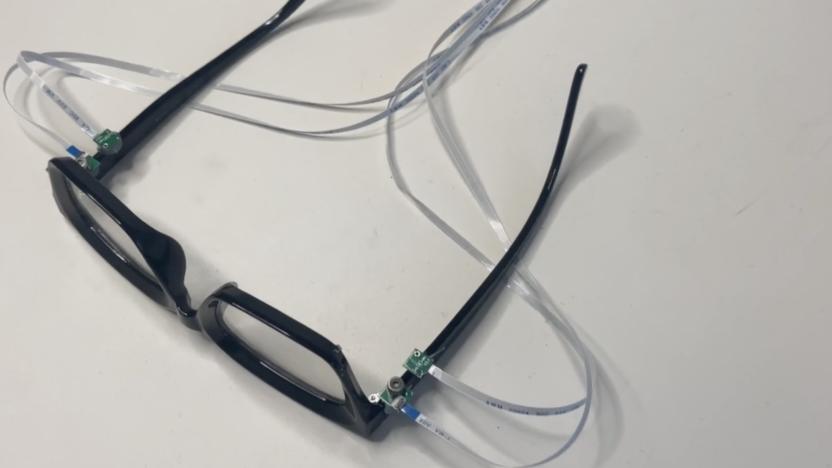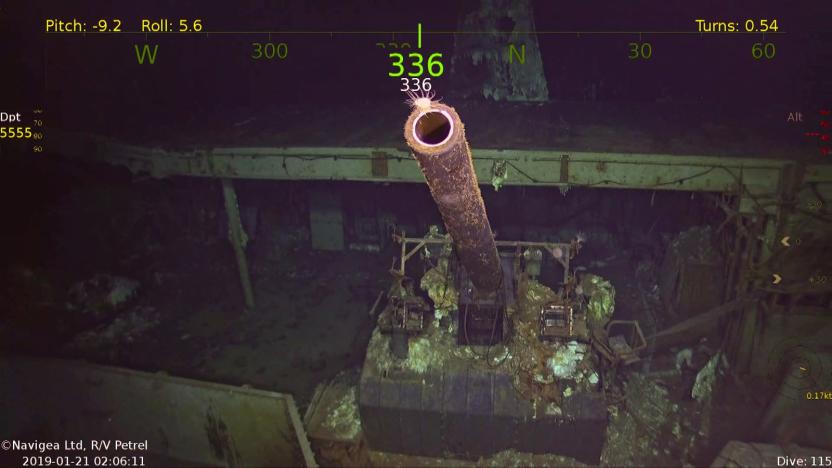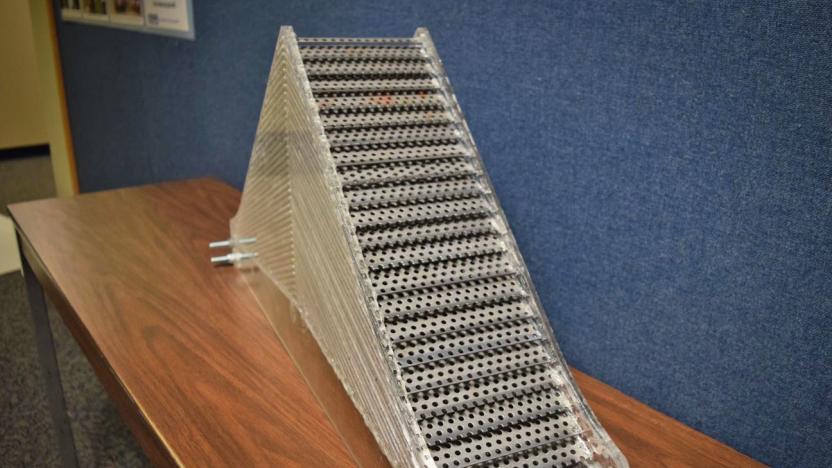sonar
Latest

These sonar-equipped glasses could pave the way for better VR body tracking
A team from Cornell University fitted a pair of eyeglasses with a tiny sonar system to demonstrate how the technology can track the body's movement via acoustic signals.

Researchers built sonar glasses that track facial movements for silent communication
A Cornell University researcher has developed sonar glasses that “hear” you without having to speak.

Researchers made a sonar-equipped earphone that can capture facial expressions
The 'earable' bounces sound off the inside of the wearer's cheeks to detect face movements.

2022 Honda Civic adds wireless connections for CarPlay, Android Auto
The redesigned 2022 Honda Civic has smarter driver assists to go with available wireless connections for Android Auto and Apple CarPlay.

Sonar drone discovers long-lost WWII aircraft carrier USS Hornet
The late Paul Allen's research vessel, the Petrel, has found another historic warship at the bottom of the ocean. In the wake of an initial discovery in late January, the expedition crew has confirmed that it found the USS Hornet, an aircraft carrier that played a pivotal role in WWII through moments like the Doolittle Raid on Japan and the pivotal Battle of Midway. It was considered lost when it sank at the Battle of Santa Cruz in October 1943, but modern technology spotted it nearly 17,500 feet below the surface of the South Pacific Ocean, near the Solomon Islands.

MIT finds a way for submarines to talk directly to airplanes
Submarines can't normally communicate directly with anything above the water due to the physical limits of their signal, but that might change in the near future. Researchers have developed a wireless system that can transmit data from an underwater source to the air. The approach, known as translational acoustic-RF communication (TARF), sends a sonar signal to the surface, where tiny vibrations at different frequencies correspond to the 0s and 1s of binary data. Above the water, an extremely high frequency radar (30GHz to 300GHz) can pick up on minuscule changes in signal angles that relate to the data bits. It's just a matter of processing the bits into meaningful data after that.

Researchers create an acoustic cloaking device that works underwater
The concept of a cloaking device has a lot of appeal and though we're far from being able to make 3D objects invisible to the human eye, researchers continue to develop new ways in which to shield objects from other sorts of detection. At the Meeting of the Acoustical Society of America taking place this week in Minnesota, Penn State University researchers described a design they've developed that allowed a 3-foot-tall pyramid made from perforated steel plates to deflect sound waves in a way that could make it invisible to instruments like sonar.

Missing Malaysia Airlines flight search yields valuable seafloor data
In 2014, Malaysia Airlines flight MH 370 disappeared from radar and a massive search for the missing aircraft ensued. For two years, scientists used sonar to map the seafloor where the plane was thought to have crashed, and then search for any remnants. Nothing was found and the search was officially called off this past January, but the data collected during the search has now been released.

The PowerRay drone is an aquatic spyglass for playboy fishermen
Who needs fishing prowess when you have a remote-controlled, sonar-equipped, bait-dropping, mini-submersible at your disposal? Because with the new PowerRay underwater drone, that's exactly what you get.

Simulation of hidden ocean tides could lead to better sonar
There's a lot of tidal movement under the ocean's surface, but we haven't had a great understanding of it so far. Internal tides, created around continental shelf breaks, are far more difficult to predict than the ocean waves you can see. However, MIT researchers just made a breakthrough: they've accurately simulated those hidden tides for the first time. They melded a hydrodynamic model with data from a coastal sound wave study to replicate an ocean environment (in this case, a shelf break near the US' eastern coast) with a previously unseen level of complexity, complete with background elements like currents and eddies. The technique should be useful for predicting climates and fishing populations, but it could lead to a surprising amount of technological progress, too.

The Power Egg is unlike any drone you've ever flown before
try{document.getElementById("aol-cms-player-1").style.display="none";}catch(e){}Normally, when you think "quadcopter", you think of the standard block-shaped mass of propellers, struts and landing gear. But nothing says they have to look that way. In fact, one drone company from China is taking a radically different approach with a UAV that looks like something from the labs of Capsule Corp.

ForcePhone software makes any mobile device pressure sensitive
A team from the University of Michigan have developed a novel means of giving any mobile device the same sort of force-sensitive capabilities found on Apple's flagship iPhone 6s. Dubbed ForcePhone, the software leverages two features that literally every smartphone has -- a microphone and a speaker -- do to what very few OEM device manufacturers have managed.

This DIY sonar glove can 'feel' distant objects underwater
If you live in a relatively dry climate, you probably don't worry about underwater hazards during the flood season. If you attend Tsukuba University, Japan however -- just miles from where the Kinugawa River flooded Joso City earlier this year -- the risk of rising water is a very real threat. Enough so that two Tsukuba Ph.D. candidates have developed a 3D-printed sonar glove specifically for the purpose of searching flood waters.

ICYMI: Egyptian tomb tech, new fusion reactors and more
#fivemin-widget-blogsmith-image-20787{display:none;} .cke_show_borders #fivemin-widget-blogsmith-image-20787, #postcontentcontainer #fivemin-widget-blogsmith-image-20787{width:570px;display:block;} try{document.getElementById("fivemin-widget-blogsmith-image-20787").style.display="none";}catch(e){}Today on In Case You Missed It: Everyone who ever wanted to be Indiana Jones or just give up on it all and join an archeological dig will be interested in this: A new project called "Scan Pyramids" will use infrared scanners and cosmic ray detectors to search for new tombs inside pyramids in Egypt, as well as attempt to discover the engineering details of how pyramids were constructed. Fascinating stuff! Plus scientists at the Max Planck Institute want to launch a new design for a fusion reactor. It has a twisted shape unlike the traditional donut design, which its scientists believe is safer than the first version.

Drones help find World War II's missing soldiers
The BentProp Project has spent years finding American soldiers who went missing in the Pacific during World War II, but available technology has limited its success. Team members have frequently had to scan wide areas themselves, slowing down their efforts to find downed aircraft and unexploded bombs that might hide human remains. However, the outfit's searches have just taken a big step forward after it got cutting-edge drones from both the Scripps Institution of Oceanography and the University of Delaware. BentProp can now automate much of its scanning, and CNET notes that the organization's latest expedition found two Navy airplanes. That's a breakthrough for a group that only occasionally makes a big discovery.

NASA's humanoid Valkyrie robot could lead the way to Mars (video)
NASA's Robonaut is only just getting its legs, but it already has some fresh (and arguably superior) competition. The agency's Johnson Space Center has given IEEE Spectrum a sneak peek at Valkyrie, a DARPA Robotics Challenge entry built to take on dangerous tasks that would normally require a human presence. In addition to sporting more joints than many of its typical two-legged rivals, the sometimes autonomous machine is chock-full of cameras, LIDAR and sonar that help it quickly move around. It can operate under planetary gravity loads that Robonaut can't touch, and even an inexperienced user can keep it running; the modular design lets astronauts swap out batteries and replacement limbs within minutes. Valkyrie isn't guaranteed to enter service, as it will have to win the support of both DARPA and NASA officials before it progresses much further. If it passes muster, however, it could be vital to NASA's long-term plans for Mars -- robots such as Valkyrie will likely prepare any future Martian landing site and assist humans once they arrive.

'Sonar Vision' system touted by researchers to help the blind hear what they can't see
Scientists from the Hebrew University of Jerusalem have developed a prototype system that could one day aid the congenitally blind by converting video into auditory cues. The "Sonar Vision" works in a similar way to a bat's echolocation system, but instead of chirping, uses a video camera embedded in a pair of glasses. A laptop or smartphone then converts the images into sound, which is transmitted to a headset. After 70 hours or so of training, that allowed users to identify objects like faces or houses, position objects in space and even identify individual letters. Surprisingly, researchers also found that after only several hours using the device, regions of the cerebral cortex dedicated to sight became activated for the first time in the congenitally sightless. That could possibly let doctors "wake up" regions of the brain never before used, according to the team, "even after a lifetime of blindness." [Image credit: Wikimedia Commons]

University of Victoria's Mano underwater robot to prowl Arctic waters for legendary ships
Canadians well-versed in their history are very aware of Sir John Franklin's ill-fated 1845 expedition to find the Northwest Passage: a British voyage that set out to establish a sailing route through the Arctic and ended with the untimely, mysterious deaths of its two ship crews. No human ever found the abandoned ships, which makes it all the more fitting that the next best shot at discovery might come through a just-launched autonomous underwater vehicle from the University of Victoria and Bluefin Robotics. Meet the Mano, a new sonar-toting robot that can produce detailed undersea maps all by its lonesome while keeping a steady altitude above the ocean floor. It can only operate for 12 hours at a time, which will keep humans in the area, but its ability to run untethered below storms and cold Arctic winds should dramatically expand the territory that researchers can cover during their share of a larger five- to six-week journey. There's no guarantee that the Mano will hit the jackpot, or find something recognizable even if it does. Still, any mapping should improve navigation for modern boats -- and hopefully prevent others from sharing Sir Franklin's fate.

City of Steam's blind-as-a-bat race
While their name might sound like something a cat hacked up in your sock drawer, the Draug are actually the latest revealed race in City of Steam. Boasting a line of noble Elfish blood dating back to whenever, the Draug eschewed adapting and instead became a reclusive society living off the remnants of its former glory. Interestingly enough, the Draug have incredibly poor eyesight, which probably should make them terrible adventurers. But in another clever City of Steam twist, the race compensate for their bad vision with bursts of sonar to "see" around them. That's right: The Draug are bat-men. And bat-women. A dev journal on the Draug talks about how this echolocation works both for and against these batfolk. While they have an advantage in low-visibility situations over normal folks, they're more blind than usual if there's a lot of noise nearby.

Insert Coin: Deeper Smart sonar Fishfinder for Android and iOS
In Insert Coin, we look at an exciting new tech project that requires funding before it can hit production. If you'd like to pitch a project, please send us a tip with "Insert Coin" as the subject line. We can't say a smartphone-connected sonar fish detector ranks high on our must-have list, but man is it a cool idea. Friday Lab's taking the plunge with its Deeper Smart Fishfinder -- a spherical waterproof device that beams back individual fish depth and location info, along with temperature and floor depth to your Android 2.2+ or iOS 4.0+ smartphone or tablet within 150 feet via Bluetooth. You simply use a standard rod and line to lower Deeper from a bridge, boat or shore, and the device automatically powers on when it makes contact with water -- a six-hour battery should suffice for all but the most dedicated of fishermen, unless they have a USB power source nearby for charging. Naturally, the sphere is water- and shock-resistant, and can operate in temperatures ranging from -10 to 40 degrees Celsius (14 to 104 degrees Fahrenheit). The Deeper app also provides air temperature and moon phase readouts, and social media functionality that lets you post fishing updates to Facebook or Twitter -- so all of your less fortunate friends can see how much fun you're having catching fish and stuff. The first 60 Deeper backers can snag one set for $129 (plus $20 shipping) on Indiegogo, while latecomers can hop on board for $20 more. You can also place your pre-order through the company's site, also for $149. There's just shy of four weeks left for Friday Lab to meet its $49,000 goal, so hit up our source link after the break to show your support. And if you're not quite ready to commit, there's a video awaiting you there as well.











